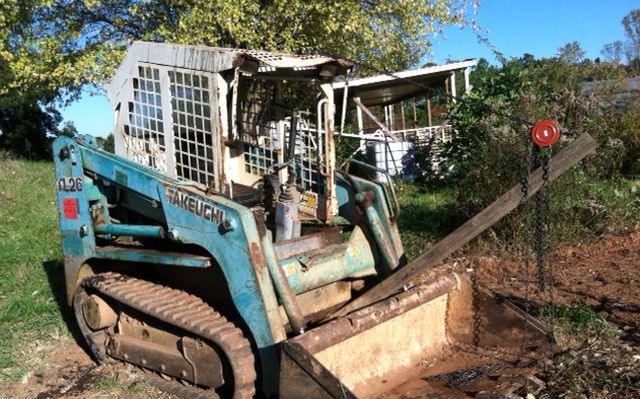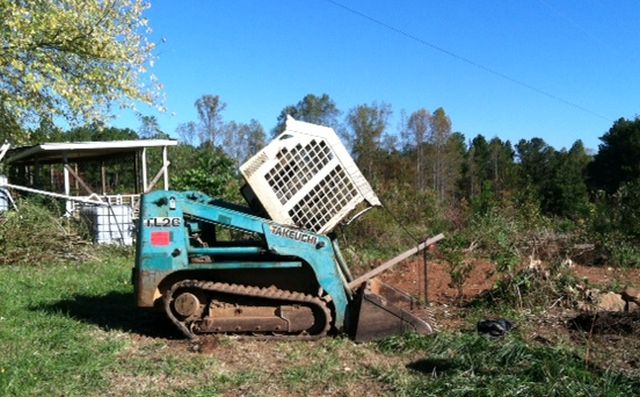This is a long discourse on engine repair- so if you aren’t interested in this subject you should skip or you will find it incredibly boring.
It began a few weeks ago. My Takeuchi TL26 track bobcat has always had an iffy battery. Even with a new alternator it often struggled to start the engine and the last few occasions I had to charge it before it would start the engine. I bit the bullet and bought a new tractor size battery from the local Tractor Supply Store. The next couple days were flawless (in terms of starting the bobcat), and I cleared an area of brush and privet in preparation for a planting of chestnut and hazelnut – yes I know chestnut is plagued by blight and Georgia is probably too hot for hazelnut but what the heck, so I bought 15 of each from Badgersett Research Corporation and will take my chances.
Now I digress again – I remove small trees, roots and all, by winding a chain round the trunk at the bottom and securing with a clevis slip hook – it’s a hook which allows the chain to slip through as you pull on the other end of the chain, thus tightening the grip. I secure the other end of the chain to the bobcat loader about 4 ft off the ground and I then drag the tree out. I keep the loader high off the ground so that if the chain snaps it will go over the bobcat not at me. I was using a lighter chain than usual and it did snap (first time for me) but it did not whiplash. My buddy, who was an engineer with the army in Germany, told me of men being killed when cables used for dragging heavy equipment snapped. Both a cable and a chain stretch however when a cable snaps it shrinks like an elastic band and that creates the whiplash. When a chain snaps the links which are stretched retain their shape so it appearsthere is little or less whiplash. I tried this theory on my buddy and he understood the argument but said stretched chains can be very dangerous, so be careful.
Anyhow, my bobcat was performing so well I decided to switch it off while I did some cleanup before heading back to base. Big mistake, I should just have left it idling. When I tried to start it for the ride back to the house nothing happened, zilch. Absolutely dead. Even the gas gauge did not move.

Over the next 3 days I tried everything. First thoughts were the wires to the ignition switch had come loose. I unbolted the control panel and inspected the wiring, all screwed tight. Then I thought a fuse had blown, so I pulled out all the individual fuses and tested them for continuity and they were fine. Then I thought the battery cables might be loose, but they were fine. So I visited the local Kobota distributor and discussed the problem with an obliging workshop foreman, Jeff. He said it was obviously electrical and I should recheck the battery cables for cleanliness and the functioning of the ignition switch. He also gave the ‘phone number of Steve, a local mechanic experienced with Takeuchi. I disconnected the battery cables and checked the functioning of the ignition switch with a continuity tester – it was fine. I thought I might have a bad earth so I connected a jump start cable from the negative terminal of the battery to the chassis – nothing. Next day I brought out with me a battery tester which applies a load across the battery, thinking the battery may have suddenly failed. The battery was fine.

So time to call Steve, First thing he said was he had a 2 week backlog. But he was prepared to listen. When I told him the battery was fine he said check the fusible link in the wire which leads to the starter solenoid and if this was ok then apply a hot wire (wire direct from the positive battery terminal) to the starter solenoid. I couldn’t find the fusible link but I tried and retried various ideas to no avail. To get smart I decided I needed a workshop manual. There are typically 3 types of manuals – operator’s manual, parts manual and workshop manual. Parts manuals are easy to come by and have a wealth of information and are provided free by several online parts sellers. The operator’s manual is usually available free from the manufacturer. I had both of those. I mulled signing up with a website in Asia which offered the workshop manual under a bonus points plan. But I fortuitously discovered, before I went down that road that 3 years ago I had purchased a workshop manual which had been gathering dust for some time. (Memory, memory?) So I pored over the workshop manual for advice. Unlike the Chilton/Haynes auto manuals this one did not provide procedures on how to do things. It had a perfunctory troubleshooting section on electrics and a lot more on hydraulics, which was not the problem. So that was Friday, Saturday and Sunday gone.
Monday, my buddy Mike was between jobs and came out to visit. I dug around the wiring near the starter and found the fusible link, hooray – it looked fine and I tested it with the continuity tester and it was fine. This was a setback since I had hoped I had a bad fuse which had deteriorated with age. No such luck. I did not want the engine to suddenly start while I was perched above the engine compartment below the raised cab so I devised two long wires with alligator clips at the ends connected via a 15 amp fuse to a press switch. Then I connected one of the wires to the battery positive terminal and the other to the wire to the starter solenoid. I stood back and pressed the switch and expected it to start – zilch. Then Mike and I thought the wire might not be thick enough and we used a lower gauge (thicker wire) – nothing. I retested the battery with the battery tester – it was now a bit weak. I had noticed that when I turned the ignition key occasionally the gas gauge needle would move and once I heard a click. So I was now coming to the conclusion that I had a bad solenoid or starter. The solenoid is attached to the starter and its main function is to take the current from a small wire from the ignition switch and use that to connect the big wire from the positive terminal of the battery to the main terminal of the starter. The problem could be the solenoid was not working or it was working but the teeth of the starter were jammed or the brushes of the starter were faulty. What intrigued me was that I had never had a problem with the starter and when they start to fail there is usually good warning, so this seemed unusual. Anyhow – what to do next.
I thought extra current might help so I drove my truck up and tried jump starting the bobcat. I heard a click and that was all. My neighbor across the road, Greg, is an automobile bodywork specialist and he said tapping the starter with a hammer might loosen a jammed part and get the starter to work so I could drive it back to the house. I used a steel hammer to hit a 2 by 6″ piece of wood onto the starter – nothing happened. Greg later that afternoon said it had to be steel on steel not wood on steel, and not too hard. But I had had enough for the day.
Greg suggested I contact a wrecking service and have them lift the bobcat onto the back of a truck and move it to my house where I could work on it at my leisure. So I called Steve, the local mechanic expert, and he still had a 2 week backlog but, on questioning said that the starter could be replaced in the field and it did not have to be done in a workshop. He also said that if/when he came out he would have the starter repaired rather than buy a new one. I asked him about towing and he said that the tracks do not move if the engine is not running and while it could be winched onto the back of a truck, getting it off could be difficult. I contacted a wrecking service and they initially declined thinking the bobcat was out in a field but agreed when told it was easily accessible from a gravel road. They said they had lots of experience loading and unloading track bobcats.
(continued in part 2)
